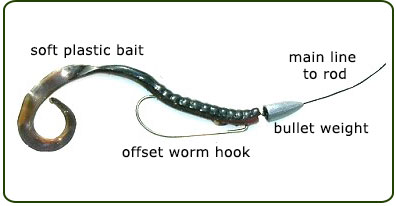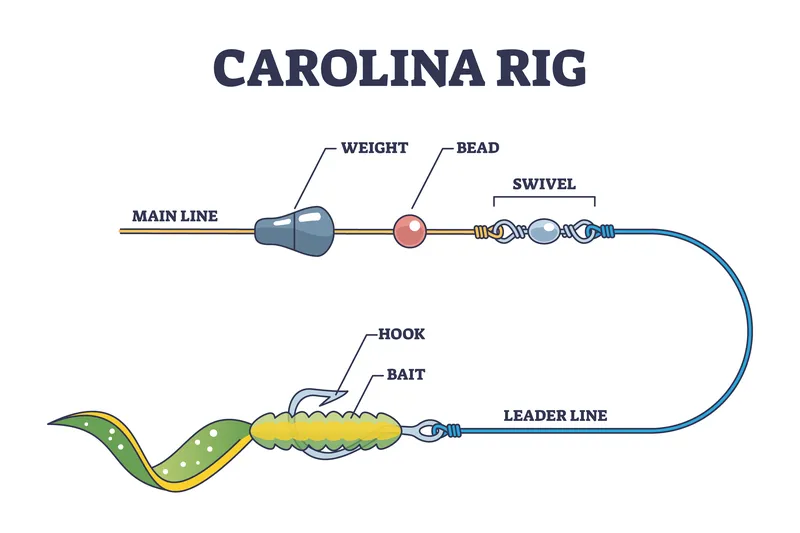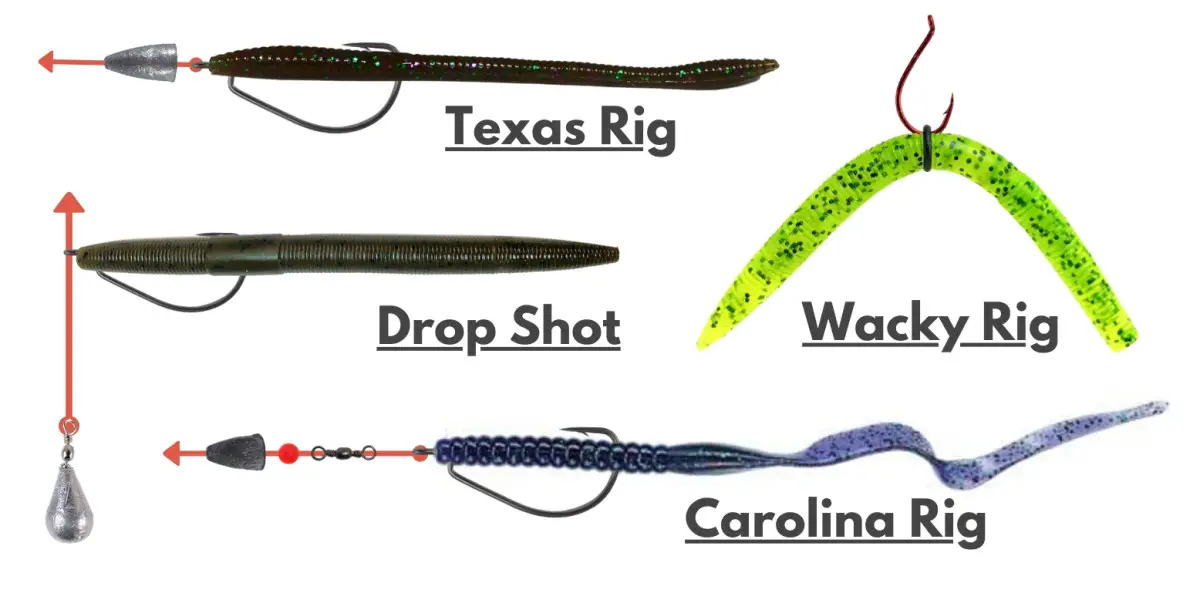Depending on the hook you use, the two most popular freshwater fishing setups using an artificial plastic worm are a Texas rig and a wacky rig. There should be plenty of useful images on Google and the hooks themselves are usually labeled at the store. How do you put a plastic worm on a hook?
- Choose a 3/0 or 4/0 worm hook.
- Insert the hook into the worm’s head.
- Thread the hook about ¼ inch through the body.
- Bring the hook point out.
- Slide the worm up to cover the hook eye.
- Rotate the hook point toward the worm.
- Insert the hook point back into the worm.
- Slightly embed the hook point to avoid snags.
Getting the hang of fishing plastic worms can greatly improve your fishing success, especially when you’re after big bass. By picking the right type of worm, rigging it correctly, and tweaking your presentation to match the conditions, you can effectively imitate a natural food source and attract more bites.
Introduction:
Hooking a plastic worm correctly is a fundamental skill in fishing, especially when targeting bass and other freshwater species. Plastic worms are highly effective lures due to their lifelike appearance and movement in the water. Properly hooking the worm ensures it stays securely on the hook, swims naturally, and reduces the chances of snags. Additionally, a well-hooked worm increases your chances of setting the hook effectively when a fish bites, leading to more successful catches. Whether you’re fishing in weedy areas or open water, mastering this technique is crucial for any angler aiming for consistent results.
How to Put a Plastic Worm on a Hook
- To properly rig a plastic worm, start by selecting the right hook, which is usually a 3/0 or 4/0 worm hook.
- Next, insert the hook into the head of the worm and push it in about a quarter inch, then pierce the body with the hook point.
- Slide the worm up the hook shaft until you reach the eye of the hook.
- Rotate the hook 180 degrees so that the point faces inward toward where you plan to trim.
- Insert it back into the worm, but don’t push it all the way through yet, leaving just a tiny bit sticking out. This weedless setup allows for effective fish hooking without getting snagged on the bottom.
How to Rig Plastic Worms for Fishing
Using plastic worms can be a game-changer for anglers aiming to reel in big bass. Mastering how to properly rig and hook a plastic worm is essential for attracting those fish lurking below the surface. Let’s explore two of the most popular methods: the Texas rig and the Carolina rig.

First up is the Texas rig, a timeless favorite among bass anglers. Begin by inserting your worm hook through the top of the plastic worm’s head, pushing it in about a quarter inch.
Guide the hook point out the side, and then slide the plastic worm up the hook until its head is at the hook’s eye. After that, rotate the hook point and carefully push it back into the worm’s body, ensuring it remains straight and weedless. This technique allows your worm to navigate through dense cover without getting snagged. The Texas rig excels in thick vegetation where bass often hide.
Now, let’s discuss the Carolina rig, which is excellent for covering more water and exploring deeper structures. To set up this rig, start by sliding a bullet weight and a bead onto your main line, and then attach a swivel to create a connection to your leader. At the end of the leader, fasten your worm hook and choose the plastic worm you prefer.
Similar to the Texas rig, insert the worm hook through the worm’s head, pull it out a quarter inch down, then slide it up the hook. Tuck the hook point back in to keep the worm straight. The bullet weight and bead create a useful clicking sound underwater, which can draw fish from a distance.

Both rigs offer distinct advantages based on the situation. By mastering these techniques, you can adjust to different fishing conditions. With some practice, you’ll discover the best way to rig a plastic worm to increase your catch rate. For more video tutorials and tips from the fishing community on how to rig plastic worms effectively, be sure to check out MyWaterEarth&Sky. Happy fishing and tight lines!
Steps to Hook a Texas Rig Worm
When you’re tackling the art of fishing, mastering the Texas rig for plastic worms can elevate your game. Today, we’ll break down the steps to ensure every hook you set is perfection itself. Let’s dive straight into the intricacies of securing that infamous worm on your hook.
First off, you’ll need to gather your tackle essentials: a Texas rig, your preferred plastic worm, and a sharp, sturdy hook. Begin by threading the head of the worm onto the hook in a straight line. This ensures it mimics the natural movement of a live worm.
Push the first quarter-inch of the worm through the hook until it reaches the bend. Here’s a helpful tip: Rotate the plastic worm so the hook point faces the underbelly of the worm as you push it up the shank. This motion ensures a streamlined presentation that won’t spook the fish. Now, gently pull the worm up the shank until it covers the eye of the hook.
The next step is crucial for the beloved Texas rig: you’ll want to align the worm perfectly along the shaft of your hook. Mark where the hook should re-enter the worm, usually at a point about a third of the worm’s length. Carefully push the point of the hook through the worm at this marked spot, ensuring it comes out the top. For the classic weedless setup, slightly embed the hook point back into the worm’s body.
This technique ensures your rig glides effortlessly through vegetation without getting snagged. Double-check the alignment of your worm and hook one last time, ensuring it remains straight for lifelike action. With practice, each time you hook a worm using the Texas rig, you’ll find your technique becomes second nature. For those looking for added helpful tips, revisiting our previous articles or watching our upcoming video tutorials on MyWaterEarth&Sky will enhance your skill set. Follow these steps religiously, and your fishing ventures will surely bring in plentiful hauls.
Tips for Hooking and Rigging Plastic Worms
When it comes to snagging that prized bass, mastering the art of hooking and rigging plastic worms is key. These soft, flexible lures are incredibly versatile, and knowing how to rig them can make all the difference.
- First let’s talk about the Texas rig, a classic, highly effective method. Slide a bullet-shaped sinker onto your line, followed by a worm hook, typically a 3/0 or 4/0 size. Then, thread your plastic worm onto the hook, ensuring it’s threaded straight to avoid any twists or spins. The Texas rig excels in heavy cover where bass loves to hide.
- Next, the Carolina rig offers another excellent option. Unlike the Texas rig, this one involves letting the worm float up off the bottom, ideal for covering larger areas and enticing those bass who are lurking near the bottom. Attach a swivel to your main line, followed by a leader line, and add a suitable sinker. Texas rig your plastic worm to the leader, allowing it to float freely behind the weight. This setup can be adjusted easily by changing the length of the leader and the weight of the sinker.
- Let’s not forget the wacky rig, which is as fun to use as it sounds. Hook your plastic worm in the middle, letting both ends dangle freely. For small bass or in clear water where a subtle presentation is necessary, the wacky rig is a winner. Use a small worm hook, and if extra weight is needed, add a split shot or a light jig head. The unpredictable motion this rig creates is irresistible to bass.
For even more versatility, try experimenting with different types of weights and tackle. Adding a shot of weight to your line can help get the worm into deeper water, while a smaller worm hook can be perfect for finesse fishing, adjusting to the conditions you’re facing.
Reviews from pro anglers often highlight that adjusting your reel speed and backline tension can further optimize your presentation. By mixing and matching these techniques, you’ll be properly equipped no matter where the day of fishing takes you.
The wacky rig is a straightforward yet effective method for fishing with soft plastic worms, particularly when targeting bass. To set up a wacky rig, you simply hook the worm through the center, allowing both ends to hang down.
This creates an enticing, erratic motion as the worm falls through the water, mimicking the natural movement of prey and drawing the attention of fish. The wacky rig is especially useful in clear water or when fish are less active, as its subtle presentation can entice strikes from even the most cautious bass. You can enhance the rig by adding an O-ring to the worm, which helps keep the bait intact and securely attached to the hook during casts and retrieves. Whether fished without weight or without.
How to Fish With Plastic Worms
Community Q&A on Worm and Hooks
Welcome to the community Q&A section of MyWaterEarth&Sky, where seasoned anglers and novice fishers alike can share their wisdom on the art of hooking a plastic worm. Let’s look into commonly asked questions to give you the edge in your next fishing expedition.
- One popular query is about the best type of hook to use when you’re trying to catch bass. For bass, many recommend using an offset worm hook, which provides better bait presentation and deters the worm from sliding down the hook shank.
- Another question we often get is how to effectively rig a worm to stay on the hook. The Texas rig is a classic setup, praised for its versatility and effectiveness. You’ll want to ensure your line is strong enough to handle a big bass while remaining flexible. Thread the worm onto the hook and let the hook point pierce back through the worm, making it weedless and snag-resistant. This is especially helpful when fishing in heavy cover, where bass love to hide.
- When it comes to adding weight to your setup, it’s crucial to strike a balance. Too much weight and your worm will plummet to the bottom; too little and it won’t sink deep enough. A small bullet weight is often the best choice according to our community fishing experts. This keeps your worm moving naturally through the water, enticing that hesitant bass to strike.
- How about the best fishing line to use? Anglers suggest going for a line that’s robust but supple, such as a braided or fluorocarbon line. These types of lines offer excellent sensitivity, so you can feel even the faintest nibble. Remember, consistency is key when you’re out there fishing.
For those looking to refine their skills or need a refresher, our next webpage will feature a detailed video tutorial on how to rig plastic worms head first. Stay tuned to MyWaterEarth&Sky for more expert tips and tricks. Happy fishing!
Video Tutorial: How to Rig Plastic Worms Head First
Welcome to another exciting article on MyWaterEarth&Sky! Today’s video tutorial’ll show you the best way to rig a plastic worm to improve your fishing game. Rigging a plastic worm head first is crucial for catching more bass, and we’re here to guide you through every step.
You’ll need a fishing rod, a reel, a quality fishing line, and a soft plastic worm. Begin by selecting a plastic worm that matches the conditions of your fishing environment. Next, thread the fishing line through the eye of the hook, ensuring it’s secured tightly.
Slide a bullet-shaped sinker onto the line, which will serve as a weight, to make your plastic worm sink at the desired depth. A key tip is to match the sinker to the worm size to maintain a natural presentation in the water. In this video, we’ll cover the exact techniques for threading the hook through the head of the worm. Make sure you insert the hook straight through the center of the head to avoid tearing the soft plastic.
Run the hook out about 1/4 inch and then back it out the same distance, ensuring the worm is aligned straight on the tackle. This method, known as the Carolina rig, is highly effective for bass fishing. One common mistake anglers make is not ensuring their worm is perfectly straight on the hook. This could cause unnatural movement, scaring off potential fish. Our video tutorial will demonstrate how to adjust the worm to ensure it mimics real prey.
Whether you’re using a weighted or unweighted shot, our tips will keep your plastic worm swimming true. To get the best hook set, watch for the bass to take the plastic worm, then reel in any slack in your fishing line and give a firm pullback.
Keep tension on the line, and you’ll have a better chance of landing that fish. With these steps, you’ll improve your fishing skills and enjoy the thrill of catching more bass. Subscribe now and get ready to elevate your fishing technique on MyWaterEarth&Sky!
Conclusion:
In conclusion, mastering the use of plastic worms can greatly improve your fishing success, especially when targeting bass. By carefully choosing the right type of worm, rigging it correctly, and adjusting your presentation to fit the conditions, you can effectively mimic a natural food source and attract more strikes. Understanding how to work the worm through different environments and using techniques like adding scent or varying your retrieval speed can further enhance your chances of landing a catch. With their versatility and proven effectiveness, plastic worms are an essential part of any angler’s tackle box, making them a reliable choice for consistent and rewarding fishing experiences.
References:
Reel Rapture-How To Rig A Plastic Worm For Effective Bass Fishing
FAQ’s



